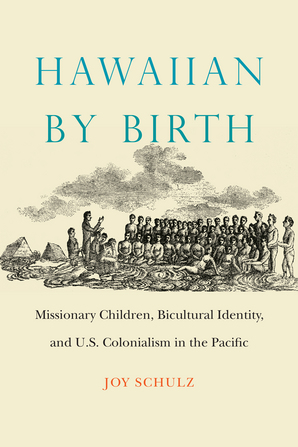Hawaiian by Birth: Missionary Children, Bicultural Identity, and U.S. Colonialism in the PacificPosted in Books, History, Media Archive, Monographs, Oceania, Religion, United States on 2017-11-09 03:20Z by Steven |
Hawaiian by Birth: Missionary Children, Bicultural Identity, and U.S. Colonialism in the Pacific
University of Nebraska Press
September 2017
240 pages
21 photographs, 7 illustrations, 1 map, index
Hardcover ISBN: 978-0-8032-8589-7
Joy Schulz, Instructor of History
Metropolitan Community College, Omaha, Nebraska
Twelve companies of American missionaries were sent to the Hawaiian Islands between 1819 and 1848 with the goal of spreading American Christianity and New England values. By the 1850s American missionary families in the islands had birthed more than 250 white children, considered Hawaiian subjects by the indigenous monarchy and U.S. citizens by missionary parents. In Hawaiian by Birth Joy Schulz explores the tensions among the competing parental, cultural, and educational interests affecting these children and, in turn, the impact the children had on nineteenth-century U.S. foreign policy.
These children of white missionaries would eventually alienate themselves from the Hawaiian monarchy and indigenous population by securing disproportionate economic and political power. Their childhoods—complicated by both Hawaiian and American influences—led to significant political and international ramifications once the children reached adulthood. Almost none chose to follow their parents into the missionary profession, and many rejected the Christian faith. Almost all supported the annexation of Hawai‘i despite their parents’ hope that the islands would remain independent.
Whether the missionary children moved to the U.S. mainland, stayed in the islands, or traveled the world, they took with them a sense of racial privilege and cultural superiority. Schulz adds children’s voices to the historical record with this first comprehensive study of the white children born in the Hawaiian Islands between 1820 and 1850 and their path toward political revolution.
Table of Contents
- List of Illustrations
- Acknowledgments
- Introduction: Imperial Children and Empire Formation in the Nineteenth Century
- 1. Birthing Empire: Economies of Childrearing and the Establishment of American Colonialism in Hawai‘i
- 2. Playing with Fire: White Childhood and Environmental Legacies in Nineteenth-Century Hawai‘i
- 3. Schooling Power: Teaching Anglo–Civic Duty in the Hawaiian Islands, 1841–53
- 4. Cannibals in America: U.S. Acculturation and the Construction of National Identity in Nineteenth-Century White Immigrants from the Hawaiian Islands
- 5. Crossing the Pali: White Missionary Children, Bicultural Identity, and the Racial Divide in Hawai‘i, 1820–98
- Conclusion: White Hawaiians before the World
- Notes
- Bibliography
- Index
